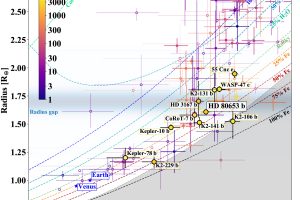Planets with ultra-short period. The study: “An ultra-short period rocky super-Earth orbiting the G2-star HD 80653” of G. Frustagli (INAF – Astronomical Observatory of Brera) recently appeared on A&A

The “Ultra-Short Period” (USP) exoplanets have very close orbits and orbital periods shorter than one day. These planets typically have a radius smaller than 2 Earth radii and a terrestrial composition, sometime with an excess of iron.
Four hypotheses have been made to explain the formation and evolution of USP planets. The main hypothesis is that these planets originate from “hot Jupiters“, e.g. gaseous exoplanets larger than Jupiter but in a close orbit, which have completely lost their atmosphere because of the intense irradiation from the host star. In fact, stellar radiation, in particular the UV radiation, can heat the Hydrogen-rich atmosphere of these planets up to 1000 degrees, making it evaporate until the atmosphere is completely removed and their solid core exposed. A similar hypothesis claims that these planets originate from “mini-Neptune” planets with a rocky core, a radius between 1.7 and 3.9 Earth radii and a mass of about 10 Earth masses. It is also possible that these planets formed with their present-day dimensions at large distances from the central star, and then they migrated inward, or that they formed in-situ.
The star HD 80653, spectral class G2V, hosts an USP planet discovered in 2018 thanks to observations made with the NASA satellite Kepler. In order to better characterize the properties of both the planet and its host star, the astronomer G. Frustagli, INAF – Astronomical Observatory of Brera, analyzed 109 spectroscopic observations of the system acquired with the spectrograph HARPS-N mounted on the Telescopio Nazionale Galileo. These observations are designed mainly to allow measurements of the radial velocity of the star, e.g. of the Doppler effect due to the periodic oscillations of the stellar position along the line of sight induced by the orbital motion of its planet. These data allowed the team to estimate that HD 80653 has a radius of 1.2 Solar radii, a mass of 1.18 Solar masses, and an age of about 3 billion years. The planet (HD 80653 b) has an orbital period of 0.7 days, a radius of 1.6 Earth radii, and a mass of 5.6 Earth masses. The bulk density of the planet suggests an Earth-like composition without atmosphere. Besides, the temperature of the planet in its day-side is of about 2500 degrees, hot enough to melt silicate and iron. This suggests that the planet hosts a magma ocean, at least covering its day-side. The study, described in the paper: “An ultra-short period rocky super-Earth orbiting the G2-star HD 80653“, recently appeared on Astronomy & Astrophysics, suggests that HD 80653 b formed at a large distance from its star, and then it migrated inward. This scenario requires the gravitational interaction with other planets, whose presence is suggested by the existing data. In future, other data will be acquired in order to confirm the presence of other planets in the system. The astronomer Giusi Micela, INAF – Astronomical Observatory of Palermo, has participated to the study.
The figure (click here to see the entire image) shows the mass vs. radius distribution of known planets whose parameters are well constrained. The typical loci populated by planets with different compositions are also marked.
